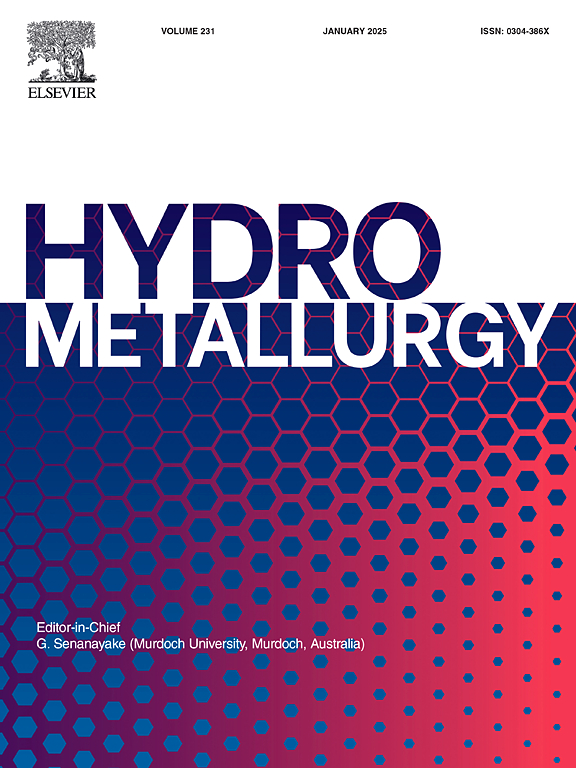The role of hydrogen peroxide in the acid dissolution of indium tin oxide (ITO) in the context of selective indium recovery from secondary sources
IF 4.8
2区 材料科学
Q1 METALLURGY & METALLURGICAL ENGINEERING
引用次数: 0
Abstract
This paper presents a thermodynamic, kinetic, and mechanistic examination of indium and tin extraction from indium tin oxide (ITO) in acidic sulfate solutions containing hydrogen peroxide (H2O2). The experimental approach included a comprehensive characterization of commercial ITO powder and leach residues by different techniques, as well as a systematic investigation of the effects of temperature, sulfuric acid (H2SO4) concentration, and hydrogen peroxide concentration on the leaching behavior (yield and rate) of indium and tin. The leaching tests showed that the presence of H2O2 in the H2SO4 solutions results in a significant increase in the leaching of indium, primarily at moderate temperatures. Furthermore, an increase in the H2O2 concentration in the solutions leads to a decrease in the concentration of tin in the leach liquor. The extraction of indium from ITO appears to occur in two steps. The first step involves the spontaneous hydration of In2O3 to form indium(III) hydroxide, In(OH)3, while the second step is the attack of this phase by protons (H+) to form soluble In3+ species, which is also a spontaneous reaction. The rate-determining step of indium extraction from fine ITO particles (mean particle size = 18 μm) is likely the diffusion of H+ through the pores of hydrated In2O3 particles and the grains of SnO2 surrounding these particles. With regard to the extraction of tin, the following sequence of steps was proposed: (i) the spontaneous reduction of the SnO2 phase in the acid solutions to Sn2+ by the active hydroperoxyl (HOO•) radical, which is formed from the decomposition reaction of H2O2; (ii) the spontaneous oxidation of Sn2+ ions to Sn4+ by the oxygen molecules and the active hydroxyl (HO•) radical, which are also formed from the decomposition reaction of H2O2; and (iii) the spontaneous precipitation of SnO2 from the unstable Sn4+ ions. A better understanding of the kinetics and mechanism of ITO dissolution in the H2SO4-H2O2 media may be helpful in the design and improvement of leaching processes targeting high indium recovery by selective leaching.
在选择性回收二次源铟的情况下,过氧化氢在氧化铟锡(ITO)酸溶中的作用
本文介绍了在含过氧化氢(H2O2)的酸性硫酸溶液中从氧化铟锡(ITO)中萃取铟锡的热力学、动力学和机理研究。实验方法包括通过不同的技术对商业ITO粉末和浸出渣进行综合表征,以及系统地研究温度、硫酸(H2SO4)浓度和过氧化氢浓度对铟和锡浸出行为(产率和速率)的影响。浸出试验表明,在H2SO4溶液中存在H2O2导致铟的浸出显著增加,主要是在中等温度下。此外,溶液中H2O2浓度的增加导致浸出液中锡浓度的降低。从ITO中提取铟似乎分两个步骤进行。第一步是In2O3自发水化形成氢氧化铟(III) In(OH)3,第二步是质子(H+)攻击该相形成可溶的In3+,这也是一个自发反应。从ITO细颗粒(平均粒径为18 μm)中提取铟的速率决定步骤可能是H+通过水合In2O3颗粒及其周围SnO2颗粒的孔隙扩散。对于锡的提取,提出了以下步骤:(1)由H2O2分解反应生成的活性羟基(HOO•)自由基将酸溶液中的SnO2相自发还原为Sn2+;(ii)由H2O2分解反应生成的氧分子和活性羟基(HO•)自由基将Sn2+离子自发氧化为Sn4+;(iii)从不稳定的Sn4+离子中自发析出SnO2。更好地了解ITO在H2SO4-H2O2介质中的溶解动力学和机理,有助于设计和改进选择性浸出高铟回收率的浸出工艺。
本文章由计算机程序翻译,如有差异,请以英文原文为准。
求助全文
约1分钟内获得全文
求助全文
来源期刊

Hydrometallurgy
工程技术-冶金工程
CiteScore
9.50
自引率
6.40%
发文量
144
审稿时长
3.4 months
期刊介绍:
Hydrometallurgy aims to compile studies on novel processes, process design, chemistry, modelling, control, economics and interfaces between unit operations, and to provide a forum for discussions on case histories and operational difficulties.
Topics covered include: leaching of metal values by chemical reagents or bacterial action at ambient or elevated pressures and temperatures; separation of solids from leach liquors; removal of impurities and recovery of metal values by precipitation, ion exchange, solvent extraction, gaseous reduction, cementation, electro-winning and electro-refining; pre-treatment of ores by roasting or chemical treatments such as halogenation or reduction; recycling of reagents and treatment of effluents.
 求助内容:
求助内容: 应助结果提醒方式:
应助结果提醒方式:


